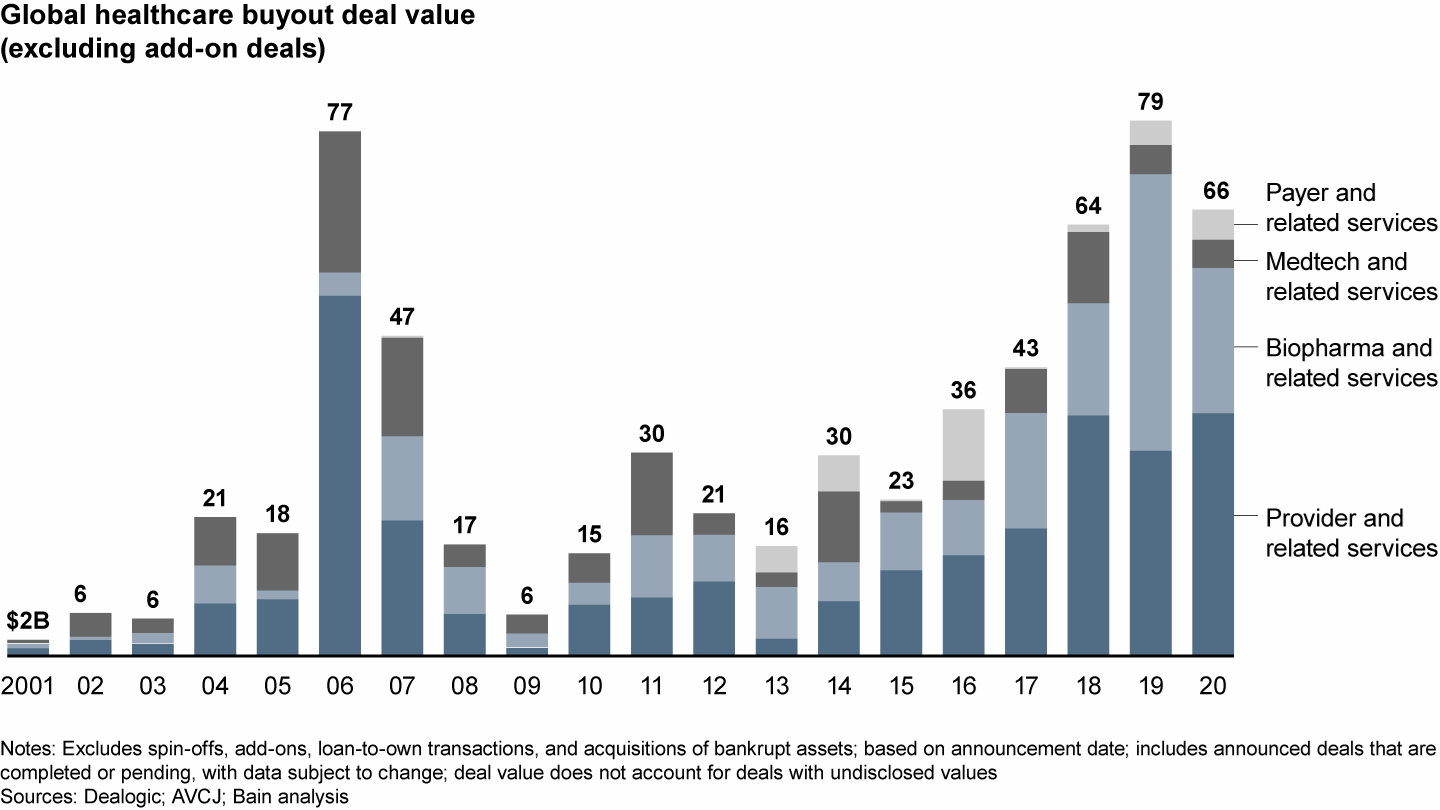Report

At a Glance
- Medtech investors completed 62 deals in 2020, slightly up from 2019, with disclosed value about flat at $4.2 billion, compared with $4.3 billion in 2019. There were no deals with disclosed value over $1 billion and only two with disclosed value over $500 million.
- This steady performance is encouraging, as Covid-19 reduced patient volume and squeezed supply chains.
- The Asia-Pacific region accounted for 48% of the total deal count, but only 17% of disclosed value. North America had 73% of disclosed value, largely on the back of the two largest deals, NN and Advanced Instruments.
- Four investment themes stand out: life sciences equipment and consumables, consumer-facing technologies, growth in Chinese activity, and opportunities in carve-outs.
This article is part of Bain's 2021 Global Healthcare Private Equity and M&A Report.
Investment in the medtech sector generally fluctuates year-to-year, so the steady performance in 2020 is encouraging. Many private equity sponsors have historically faced challenges in acquiring attractive medtech assets. On one end of the asset spectrum, private equity funds face stiff competition from corporates looking for tested, high-performing medtech targets to integrate with their broader businesses. On the other end, not all healthcare private equity investors have an appetite for more speculative, early-stage targets.
Layered on that underlying dynamic, medtech experienced major disruptions in 2020 from Covid-19. Specifically, the pandemic and subsequent lockdowns caused patient volumes to plummet, especially for elective procedures, and it squeezed standard supply chains for many of the sector’s products and device components.
Meet the members of Bain’s Healthcare Private Equity practice.
The number of deals during the year increased to 62 from 59 in 2019. Disclosed value dipped 3% to $4.2 billion in 2020 (see Figure 1). This slight decline partly stems from a lack of deals valued at $1 billion or more, whereas there were two in 2019.
Disclosed deal value dropped from the 2019 high


Four investment themes emerged from our analysis of 2020 deal flow:
- life sciences opening avenues into high-growth segments such as diagnostics;
- new attention to consumer-facing technologies that could disrupt traditional models;
- strong growth in medtech deals in China; and
- opportunities for value in carve-outs.
Life sciences diagnostic equipment and consumables are on a roll
Firms producing technology that supports R&D with clinical laboratory tools and diagnostics can benefit from tailwinds in both diagnostics and advanced drug development. Unlike many medtechs, these firms don’t make the typical surgical implants and consumables, but instead focus on high-tech devices and equipment, such as genomic sequencers for biopharma applications, used to test or develop other products or assess diseases.
As an example, Patricia Industries led the acquisition of Advanced Instruments for $780 million. Advanced Instruments has developed a broad portfolio of osmolality testing products that are used by biopharma firms and emerging cell and gene therapy biotechs across the world.
Consumerism gains a foothold
Consumers in many major markets have shown an interest in discretionary spending on healthcare products, presenting new growth avenues for medtech firms. Direct-to-consumer (DTC) channels are intriguing because medtech firms can market a product directly, and hospitals and healthcare payers have less sway over pricing and sales tactics. DTC firms with business models suited to ride the wave of healthcare consumerism have thus garnered interest from private equity investors.
For instance, Eargo, a DTC hearing aid developer, recently raised a $71 million financing round from investors Gilde Healthcare and Longitude Capital. Similarly, piggybacking on interest in veterinary medicine in the provider space, Fidelio acquired BioMedtrix and Veterinary Orthopedic Implants, two firms offering veterinary joint replacement implants.
Domestic deals in China heat up
Population growth and other macro trends have long spurred growth in China’s healthcare markets. Now the government has begun to promote domestic development of the industry in order to reduce reliance on Western firms.
These macro and political factors spurred acquisitions of Chinese medtech companies, which jumped to 25 in 2020 from a low base of 6 in 2019. Many such deals appear to focus on earlier-stage technology or targets with lower price tags, and often consist of consortium investments. Two of the larger transactions were the Hillhouse Capital-led consortium investment in MicroPort CardioFlow Medtech for $130 million and the $92 million raise for Coyote Bioscience.
Although domestic medtech firms have gained ground in China, their strategy and viability for growth abroad, where they would face increased competition from larger firms, is not yet established.
Carve-outs to unlock value
Carve-outs have allowed acquiring firms to gain entry to attractive indications, or to unlock a category leadership position in a smaller subsegment. Private equity firms actively sought out these opportunities, as evidenced by one of 2020’s largest medtech buyouts, Montagu Private Equity’s acquisition of RTI Surgical Holdings’ OEM business. The deal involves compelling technology and expected robust market growth due to macro tailwinds.
One challenge for private equity funds continues to be the competition from corporate investors looking to bolster portfolios while realizing synergies. For instance, Smith & Nephew acquired the extremity orthopedics unit of Integra Life Sciences for $240 million to broaden its product portfolio in the higher-growth extremities segment, and to take advantage of potential scale with their other orthopedics positions.
Back to a bright future
Despite the pandemic, many of the structural strengths of medical devices and life sciences tools have persisted, suggesting a return to growth in 2021. Moreover, deals deferred during the pandemic, as both buyer and seller expectations changed, should again generate interest over the coming year.
Further out, we anticipate heightened interest among private equity funds and corporates in a few highly attractive subsegments, intensifying the competition for deals. Firms with consumer-focused solutions and devices, or with technology that facilitates at-home care, such as remote diagnostics, will likely remain attractive given their ability to ride the tailwinds of shifts to home care. We also expect sustained momentum of past carve-outs and life science deals as acquiring firms look to establish strong category leadership footholds across medtech. The ability to build sector depth and operational capabilities in some of these more competitive segments will remain critical to winning marquee assets.
More from the report
-
Welcome Letter: Fertile Conditions for Healthcare Private Equity Investment
-
Healthcare Private Equity Market 2020: The Year in Review
-
The Covid-19 Paradox: Widespread Repercussions for Demand, but New Healthcare Investment Opportunities as Well
-
Healthcare Private Equity in North America: Bring On the Gem Assets
-
Healthcare Private Equity in Europe: Steady Dealmaking despite Many Deferrals
-
Healthcare Private Equity in Asia-Pacific: Riding a Wave of Domestic Innovation
-
Healthcare Providers: New Roll-Up Candidates and a New Look for Risk-Bearing Providers
-
Healthcare Payers: A Bid to Reduce Costs for Patients and Employers
-
Biopharma: Commercialization Support Services Are Thriving
-
Medtech: Four Themes Fueled Deals despite the Pandemic
-
Healthcare IT: Technologies Help Improve Patient Experiences at Lower Costs
-
Healthcare M&A: A Pandemic-Induced Slowdown in Every Sector
-
Healthcare Exit Activity: Robust Capital Markets Spur a Surge of IPOs
-
Healthcare Private Equity Outlook: 2021 and Beyond